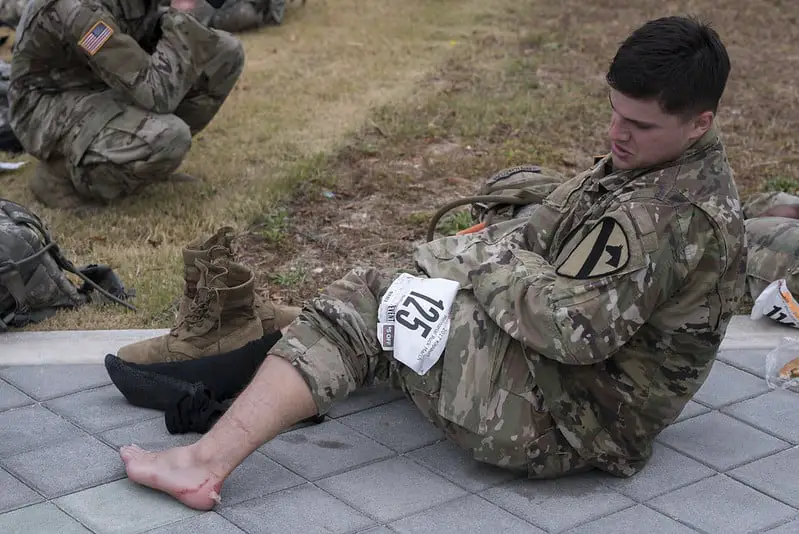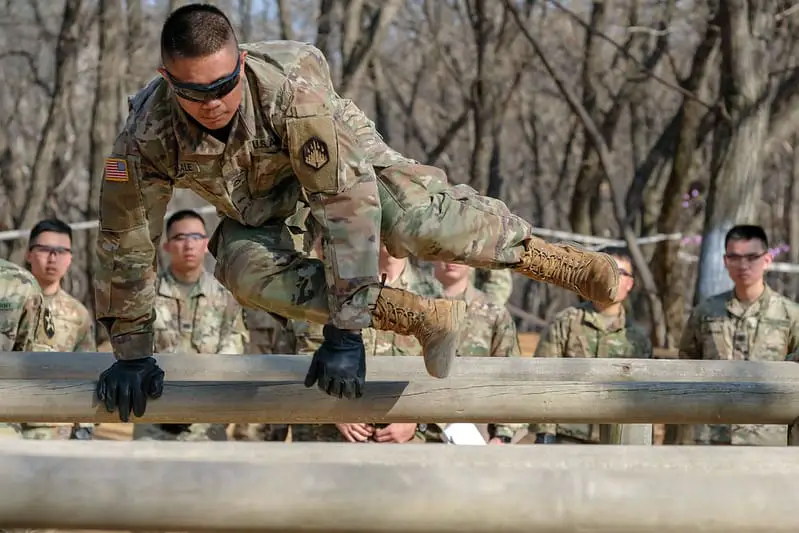How can you ruck march faster? Implementing a holistic approach is best. From lifestyle changes before the ruck, to breaking into your boots. Below is a summarized list of how you can ruck march faster:
- Preparation
- Follow a Beginner’s workout program (if you’re new)
- Nutrition
- Hydration
- Break into your boots
- Avoid Running
- Dont Stop
- Pay Attention to Rucking Speed & Pace
It’s fair to say ruck marching is a bit of an art form. If you want to learn how to do a push-up, you can just get started. If you want to run a five-minute mile, grab a pair of sneakers, get outside and start practising. It takes a lot more thought and planning to be great at ruck marching and it’s one of the reasons people are so passionate about it.
Anybody can walk with a weighted backpack. For rucking to deliver a serious muscular and cardiovascular workout, however, both weight and pace must pose a challenge. Today, we’re discussing some techniques you can use to supercharge your ruck and start completing quicker, longer weighted marches.
Always Prepare for a Ruck March

Regardless of your rucking goals, preparation is key. There are certain items you’ll need to consider no matter the length or intensity of your march. The first is suitable foot protection in the form of breathable boots with a waterproof outer layer and moisture-wicking socks.
The best socks for ruck marching are socks made from Merino Wool, as it keeps your feet breathing during the heat and keeps it warm during the cold.
It is common for ruckers in the military to wear a second pair of ‘liner’ socks beneath their main socks to prevent blisters and chafing. Especially if you’re trying to meet the army ruck march standards of 12 miles in 3 hours, achieving that goal with a blistered foot will definitely slow you down.
You’ll also need a sturdy rucksack that is capable of carrying 20lbs or more of free weight. It doesn’t need to be fancy, but it should have thick shoulder straps, a pouch for your water bladder and a chest harness to even out the weight distribution.
Check out out top picks for the best rucksacks for rucking
If your goal is to advance to faster ruck marches, you may also want to consider a hip (or ‘gut’) strap. Hip belts help to keep the weight of the rucksack closer to your back and allows you to carry the majority of the weight with your legs, it helps you distribute the weight appropriately. Without it, the majority of the weight is on your shoulders, which will slow you down.
If you’re new to rucking, don’t forget to test the reliability of your equipment before embarking on any long marches. Brand new boots should be worn in before being used for rucking. You can do this quickly by placing wet balls of newspaper into the toe section. As the paper dries and hardens, it stretches the material and creates a comfier fit.
Part of your rucking prep should include exercising to build up your muscles and endurance, learn more about the best exercises for rucking.
Start with a Beginner Rucking Program

You can’t really dive into intensive ruck marching like you can do other types of physical activity. Even if you’re familiar with the process, speed needs to be built up progressively.
The safest way to do this is to start out with a beginner’s program that enables you to increase both your weight and pace in controlled increments. Check out our guide on how much weight to carry when rucking and find out how much weight you should carry when starting out.
For instance, a beginner rucker might start by carrying 15% of their bodyweight over the course of one or two miles. Then, when they are accustomed to this weight, they might increase it by 5 or 10% every week. If you want to progress quickly and learn how to ruck march faster, you’ll need to increase weight and speed a little more each week.
You can train your body to do this by challenging yourself to complete the same distance a little faster each week. Alternatively, you could commit to a longer training schedule and increase the distance travelled each week to improve your overall endurance.
Click here for a great beginner’s program that can get you started.
Fuel Your Body with the Right Nutrients

Once you’ve perfected your technique, learning how to ruck march fast is all about the little details. Nutrition, for instance, can make a huge difference to performance and the speed at which you can move on a march. Focus on macronutrients – fat, protein, carbohydrates – because these are the food groups which deliver the most slow-release energy.
Whole-grain carbohydrates like brown rice and fresh fruits and vegetables are excellent at providing the body with glucose for energy over long periods. It’s okay to eat some fast releasing carbohydrates such as high fat snack bars and even candy.
However, you shouldn’t rely on foods which are very sugary. If eaten at all, ‘junk’ snacks are best consumed when you’re already on the trail, your body is weary and you’re in need of instant energy.
Protein is important for ruckers before, during and after marches. If you consume the right amount of protein-rich foods (lean meat, fish, poultry, milk, cheese, etc) as part of your diet, you’ll find it much easier to recover after intensive outdoor sessions.
You’ll progress at a quicker rate and should find it easier to add speed to your march because your damaged muscle tissues will be regenerating faster.
It’s Never Too Late to Hydrate
Hydration is rarely covered in detail by ruck marching guides. If you don’t recognize its importance, you probably shouldn’t be out there. To ensure your body is properly hydrated and in the right condition for a fast march, drink around a gallon of water on the two days before your session.
If you’re unsure about your hydration levels, the colour of your urine can tell you a lot. The darker the colour, the closer to dehydration you are.
On the other hand, you don’t want completely colourless urine either. If this happens, start drinking a little less water to ensure you’re not losing out on too many electrolytes. For an extra boost at the starting line, slowly sip on a sports drink in the hour before you march.
Healthy fats are essential because they provide fast-acting, slow-release energy and accelerate the body’s absorption of nutrients. While we tend to reach for high sugar foods when flagging during a workout, actually, foods rich in polyunsaturated and monounsaturated fats can do the same job more efficiently. Nuts and seeds are great examples: both can be eaten quickly and easily when out on a march.
Don’t Show Up in Fancy New Boots

To reiterate, you should never embark on a ruck in brand new footwear. It’s a fast track to painful blisters on the toes and heels. Adding speed to a march requires you to be as comfortable as possible. If you’re constantly stopping to tend to your feet, the quality of your ruck march is going to suffer.
If you’re prone to blisters, use vaseline on sensitive area on your foot. This will lessen the friction, and help you ruck faster. So be sure to pack your rucksack accordingly.
For more rucking tips, check out our top 15 rucking tips.
Use the wet newspaper technique to ‘wear in’ new boots so they’re not unaccustomed to the shape of your feet come ruck day. You can assess the overall fit of your boots by checking the ball of your foot is resting in the right place, at the widest point of the sole. Ideally, there should be half an inch of space between your biggest toe and the front of the boot.
Here’s a full guide on how to prevent rucking blisters.
Avoid Running When Ruck Marching
This might seem like an illogical thing to say particularly if your goal is to ruck march at faster speeds. However, ‘faster’ in this scenario just means covering more ground in the same amount of time. Running over long distances with a weighted rucksack is not good for the body and, contrary to what you might assume, it’ll likely slow you down.
Running is only going to consume your energy and reduce your chances of making it to the finish line. In competition scenarios – where ruckers are ‘racing’ to complete a march – it’s common to see participants taking longer strides to replicate running without burning themselves out. Some other speed tips include walking in a zigzag pattern up hills and descending the same hills with bent knees to reduce impact.
Learn more about rucking vs running.
If You Want to Be On Top, Try Not to Stop

The perfect ruck march is one that’s completed in a single ‘walk’ with no prolonged pauses for sitting or resting. This is tougher than it sounds, and it may take you several attempts at the same route before you can do it.
However, once you’ve mastered the art of staying on your feet and maintaining some movement at all times, even when rehydrating and snacking, you can really start to enhance your performance.
Not stopping doesn’t mean never slowing down. You will need to decrease your speed to replenish your electrolytes and to overcome obstacles like hills, roads and creeks.
The important thing is you don’t sit down and come to a full stop. It is much harder to recover from a complete stop and go from stationary back to full speed than it is to walk slower for a time.
Rucking Speed & Pace
The minimum military rucking pace and speed is currently set to 4 miles per hour. This is the speed and pace you should be aiming for when rucking.
This may be hard for folks who just started their rucking program, but again that’s a pace mandated by the army. The closer you can get to that the better, this ensures that you’re rucking workout is intense.
Remember in the beginning you should be rucking at your own pace and work your way up!
The Final Word on Ruck Marching for Speed
Whether you’re ruck marching alone or as part of a competitive process, getting the details right can make a huge difference to your performance. There’s a reason rucking has a reputation as the ‘thinking man’s’ workout. The physical activity itself couldn’t be simpler; you’re just travelling a specific distance with a weight.
The preparation, however, sorts the amateurs from the pros because it requires advance consideration of macronutrients, hydration, foot protection, posture, pace and lots more. To ruck march fast and skilfully, you need to do much of the work before you ever get near the intended trail or course. If it was easy, it wouldn’t be as much fun now, would it?
